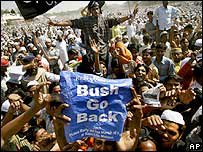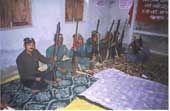While President George Bush went to
From the BBC World Service, 02 March, 2006:
“President Bush has been formally welcomed at the start of a three-day visit to
Both sides hope to finalize a deal on civilian nuclear co-operation. The agreement would see
However, the visit has been criticized by left-wing and Muslim groups, which have begun a series of rallies against Bush and the

Bush was able to put together a deceptive photo-op that made his trip look like a stunning successs. But that was façade. In reality, violence has plagued much of the country leaving some of its states in civil war. Shortly before he made his “goodwill” visit:
Five feared killed in Maoist attack in
Kolkata February 26, 2006:
Five people were feared killed and three injured after Maoist rebels blew up a police jeep in
The driver of the vehicle, a Home Guard constable, two policemen and a villager were feared killed, while three were injured, Inspector General (Law and Order) Raj Kanojia told IANS.
Police sources in Kolkata said the Maoists had laid a landmine at Nakrajhora under Belpahari area of the district, about 100 km from here.
The convoy of West Midnapore District Superintendent of Police Ajay Nanda on a combing operation was on its way to Belpahari from Nakrajhora when the incident occurred at around 6 p.m., the sources said.
Nanda had a miraculous escape in the blast, the sources said.
Maoists in
A landmine was detected hours before West Bengal Chief Minister Buddhadeb Bhattacharya's visit to the area recently.
Stepping up their activities in the three districts, the rebels looted a bank in Bankura earlier this month.
On Feb 8, a fierce gun battle between police and Maoists in the Belpahari forest area had ended with the death of at least two rebels and arrest of two women cadres.
In a late night attack Jan 23, Maoists blew up a forest bungalow under construction at Bandowan in Purulia district.
Earlier on Dec 31, the Maoists had blown up a police camp and killed Communist Party of India (Marxist) district committee member Rabi Kar and his wife in the district.
The state government is planning to deploy helicopters for aerial vigil on Maoists in the affected districts in the run-up to the coming assembly elections.
And:
Maoist rebels kill 55 in landmine blast in
By Sujeet Kumar
RAIPUR, India (Reuters),
February 28, 2006 - Maoist rebels set off a landmine under a truck on Tuesday in the Indian state of Chhattisgarh, killing 55 people and wounding at least 20 who belonged to a government-backed anti-Maoist group, police said.
The attack came on the eve of a visit to the country by U.S. President George W. Bush and was one of the worst single acts of violence by Maoists in the past three decades.
Analysts said the attack showed
"Maoists set off a landmine in Darmagura area in Dantewada district, killing 55 people," senior police officer S.K Paswan told Reuters, adding those killed were tribal members returning from an anti-Maoist meeting organised by the state.
Some of the wounded were taken to neighbouring Andhra Pradesh state by helicopter.
Last year the local Hindu nationalist Bharatiya Janata Party government set up and started funding local anti-Maoist groups in impoverished and underdeveloped areas and provided arms to some members to fight the guerrillas.
Officials said hundreds of police reinforcements had been sent to the area to search for those behind the attacks.
Darmagura, 500 km (300 miles) south of the state capital
Indian Maoists, who operate in at least nine of the country's 29 states, have stepped up attacks in the past year, killing dozens of people, including police.
DANGER TO
Security analysts say
"This is a great error of judgement and the country will pay for this for decades," said Ajai Sahni, executive director of the New Delhi-based
He said Maoists were already operating in 165 of the country's 602 administrative districts and expanding their influence.
Sahni criticised the federal government's dual policy of fighting the Maoists through the local police while developing impoverished districts where the guerrillas derive their support, especially among poor tribals and lower castes.
"Development is not the answer for terrorism. You cannot outdevelop a terrorist movement," Sahni said, calling for a modern, well-equipped police force to tackle the rebels.
The Maoists, who often target those they consider government informers as well as landlords and local officials deemed to be corrupt, temporarily seized parts of a town in eastern Bihar state in November.


No comments:
Post a Comment